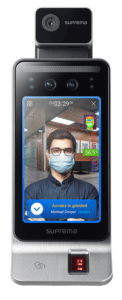
This year marks the 20th anniversary of South Korean biometric security specialist Suprema, Inc. In those two decades, the company has emerged as a proven leader in biometric access control, time and attendance, and converged security for the enterprise. In 2020, as contactless biometric technologies undergo accelerated levels of adoption thanks to the challenges presented by the COVID-19 pandemic response, we turned to Suprema to offer expert insight into the trends affecting the identity and access industry.
Tony Bitzionis, Manager of Digital Content for FindBiometrics, recently interviewed Young S. Moon, CEO of Suprema. Their conversation begins on the topic of how the coronavirus has spurred Suprema through a meaningful transformation, and then quickly transitions to the company’s latest innovation: the FaceStation F2 biometric terminal. Moon expands on how the pandemic measures have accelerated the existing trend toward contactless biometric security, and reflects on the success of the recent Suprema Connect 2020 virtual event, which may even be getting a sequel.
Read the full FindBiometrics interview with Young S. Moon, CEO, Suprema, Inc:

Tony Bitzionis, Manager of Digital Content, FindBiometrics: Young, can you tell us about how Suprema has been doing this year?
Young S. Moon, CEO, Suprema, Inc.: Despite COVID-19, and partly because of it, Suprema is going through a meaningful transformation this year. We are expanding and reinforcing contactless solutions in our portfolio to better meet the emerging market needs. In line with this trend, the most exciting event this year so far has been the launch of our new fusion multimodal terminal, FaceStation F2. FaceStation F2 is a truly innovative device that achieves exceptional authentication accuracy of 1 in 10 billion by combining visual and IR face recognition. Its multimodal offering provides flexibility and convenience to customers of all sizes. And the health and safety features, like temperature measurement, mask detection and remote enrollment, will help organizations adjust to the ‘new normal.’
FindBiometrics: As you mentioned, with the recent launch of the FaceStation F2 you decided to include both visual and infrared facial recognition technologies. What is the difference between the two, and why don’t we see both included in facial recognition systems more often?
Young S. Moon, CEO, Suprema, Inc.: Traditionally in face recognition for access control, IR technology that reads a user’s face with emitted infrared light has been widely used for its robust performance in different lighting conditions. But with the recent advancements in artificial intelligence and deep learning, the industry achieved a breakthrough in visual recognition technology and manufacturers are increasingly applying visual recognition to their face recognition devices.
IR and visual recognition technologies each have their own advantages. IR recognition performs well under dim lighting and can better detect fake faces, while visual recognition performs well under sunlight and enables remote batch user enrollment with photos. Our FaceStation F2 combines the two technologies and lets customers enjoy the strengths of both in one device. This is not an easy feat as it requires strong system performance as well as an effective optimization algorithm that combines the two recognition results optimally. We use a deep learning algorithm not only for face recognition but also for finding the optimal score fusioning between IR and visual matching. It’s not a simple addition of scores.
FindBiometrics: The FaceStation F2 is a multimodal terminal, with support for face, fingerprint, card, and mobile credentials for authentication. What are some of the advantages of this approach vs a single-modality one?
Young S. Moon, CEO, Suprema, Inc.: At the early stages of biometrics, when the market was just beginning to adopt the technology, vendors produced multimodal devices to compensate for low accuracy of biometric recognition. These days, in biometric products of leading vendors, including Suprema, accuracy is no longer an issue but multimodal is still preferred for flexibility, convenience, and security reasons. Multimodal devices offer increased flexibility by allowing organizations to pick and choose from a variety of credentials that best suit their purpose. For example, organizations can assign different kinds of credentials to different types of users. Visitors and temporary workers can be issued mobile access cards while permanent workers can register biometrics data for more convenient access. Multimodal devices can also accommodate cultural needs. In the Middle East, women who wear Niqab for religious reasons can use mobile access, fingerprint, or RFID cards instead of face recognition. In other cultures, people are more averse to submitting biometric data and prefer to use mobile access, PIN, and cards. And of course, multimodal devices can be used to enhance security at certain entry points by requiring multi-credential authentication.
FindBiometrics: We’ve all been living in a very different world for most of this year due to COVID-19 and the challenges that came with it. How do you think the coronavirus has affected the biometrics industry and your business?
Young S. Moon, CEO, Suprema, Inc.: In the recent decades, there were three key moments that dramatically changed the course of biometrics. The first was the 9/11 attacks. It was a tragic event but accelerated the adoption of biometric technology as people became more willing to compromise privacy for enhanced security.
The second was the introduction of Touch ID in Apple’s iPhone. It familiarized the public with biometrics, carving out a place for biometrics in daily lives instead of just in sci-fi films. And the third one is happening right now with COVID-19. COVID-19 increased the demand for contactless solutions everywhere and biometrics and access control were no exceptions. Technologies that do not require physical contact such as face recognition and mobile access are in demand in the post pandemic world.
Along with the rise of contactless biometric solutions, the demand for “soft” access control is also increasing. In conventional “hard” access control, the system controls when and where to allow access by the identifying and authenticating a person for security. In soft access control, we don’t only identify a person for authentication, but check whether certain conditions are met, for safety and hygiene, and grant access—for example, whether a person is wearing a mask, if the body temperature is within a range or the current occupancy of a room is below a certain level. This need for the convergence of security and safety will continue to grow after COVID-19.
FindBiometrics: Congratulations on the successful launch of your biometric showcase, Suprema Connect 2020. How has the experience of hosting your own virtual event been, and do you anticipate doing it again even when physical events are allowed to resume post-COVID?
Young S. Moon, CEO, Suprema, Inc.: In our first ever virtual event, Suprema Connect 2020, we saw a great turnout with thousands of partners and customers participating from around the world. We were able to introduce Suprema’s contactless solutions including the FaceStation F2, our recently released fusion multimodal terminal.
It was so successful and we would like to continue to hold similar virtual events, not just because of the high participation, but because the length and quality of time participants spend with us is longer and better at virtual events than at physical events. While visitors at offline exhibitions rarely allot enough time and energy to learn about our solutions in depth, at online events like Suprema Connect we can get participants’ undivided attention. We can engage customers and partners with plenty of useful and detailed content and interactive communication.
FindBiometrics: Contactless biometrics had been growing in popularity even before COVID, and are now among the hottest segments in our industry. Do you expect this trend to continue, and if so what do you think the future has in store for the evolution of the technology?
Young S. Moon, CEO, Suprema, Inc.: The pandemic left us aware of the importance of preparing facilities and communities for a similar major health threat, and contactless biometrics like face recognition will be at the core of the change, especially with the advances in AI technology boosting the paradigm shift.
Solutions with safety and hygiene features are gaining traction as well. For example, Suprema face recognition devices can detect face masks, alerting and limiting access of users not wearing masks. Suprema also started offering thermal camera modules that can be combined with face recognition devices to detect skin temperature and control access of people with elevated temperature. In software, features like occupancy limit that help with social distancing by maintaining a certain number of people in confined space are popular. Remote user enrollment feature that reduces contact and helps stop the spread of infectious diseases are also sought after.
Mobile Access solutions will see more demand next year as the need for contactless solutions rise and our dependency on smartphones remains stronger than ever. On top of the traditional BLE, NFC communication, Mobile Access solutions will also incorporate QR code into the system. Devices that help organizations adopt mobile access solutions at lower cost such as Suprema’s Airfob Patch will also be popular. Airfob Patch translates BLE signal to RF card signal, enabling communication between Mobile Access Cards and existing RFID card readers. With Airfob Patch, organizations do not have to replace existing RF card readers or carry out complicated and costly wiring work to use mobile access. Simply attaching the patch to existing readers is enough.
FindBiometrics: Finally, what can we expect from Suprema moving forward in 2020 and beyond?
Young S. Moon, CEO, Suprema, Inc.: COVID-19 resulted in lockdown and business delays, causing demand to shrink in the first half of this year. We’re seeing the suppressed demand coming up again in the second half as businesses adjust to the post-pandemic world. Suprema will respond to the demand with our best efforts, continuing to introduce and promote contactless solutions.
Another thing that’s special about 2020 is that it marks the 20th anniversary of Suprema. I dare say that Suprema has been a leader in the biometrics industry in the past twenty years, bringing unprecedented innovation and breakthroughs to the market. Suprema will strive to maintain our position as a biometric leader in the next 20 years and more. We will especially try to strengthen our position as a ‘total credential provider’ in the coming years by offering a wide variety of credential options including fingerprint, face, mobile access, and RFID cards.







Follow Us